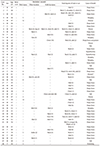Abstract
Hesitation wounds are tentative, superficial incised wounds around the fatal wound(s). This study aimed to investigate the frequency and characteristic features of hesitation wounds including ordinary incised wounds and knife tip injuries as hesitation marks from the autopsy cases of suicides using sharp force instruments. The subjects were 478 cases out of 3,131 suicide cases autopsied at the Department of Forensic Medicine, School of Medicine, Kyungpook National University in Daegu, from August, 2001 to 2013. 48 cases (approximately 10%) were suicides using sharp force instruments. In 27 cases (56.3%), the sharp force was successfully applied causing suicide; 17 cases (35.4%) were so called complex suicide cases, in which two or more different methods including sharp force injury were used; and the 4 remaining cases were suicides caused by other reasons. Overall hesitation wounds had a high frequency of 33/48 cases (68.8%). The frequency of cases in which knife tip injuries were found was lower, appearing in 13/33 cases (39.3%). The most preferred sites of knife tip injuries were the abdomen (9 cases), neck (4 cases), chest (3 cases), and face (1 case) in these 13 cases, including several overlapped cases. The average number of knife tip injuries was 14.6. A total of 88.2% of knife tip injuries was found near the incised hesitation wounds or fatal wounds. In conclusion, knife tip injuries may be a significant factor in identifying hesitation wounds, and they should be precisely examined and evaluated during autopsies to determine the manner of death.
Figures and Tables
Fig. 1
There are 4-5 knife tip injuries including 2 incised wounds and obvious 4 stab wounds in the neck.

Fig. 2
There are numerous knife tip injuries adjacent to the multiple parallel stab wounds around the umbilicus.

Table 1
Distribution of wrist scars, hesitation wounds, fatal sharp force injuries and the cause of death in 48 autopsy cases of suicide with sharp force injuries from August 2001 to December 2013 in Daegu and Kyungpook Province near Daegu

Table 2
Total number of sharp force injuries in 48 autopsy cases of suicide with sharp force injuries from August 2001 to December 2013 in Daegu and Kyungpook Province near Daegu

References
1. Kang DY, Kang HW, Kwak JS, et al. A textbook of Legal Medicine. Seoul: Jungmunkag;2007. p. 127–128.
2. Karakasi MV, Nastoulis E, Kapetanakis S, et al. Hesitation wounds and sharp force injuries in forensic pathology and psychiatry: multidisciplinary review of the literature and study of two cases. J Forensic Sci. 2016; 61:1515–1523.


3. Brunel C, Fermanian C, Durigon M, et al. Homicidal and suicidal sharp force fatalities: autopsy parameters in relation to the manner of death. Forensic Sci Int. 2010; 198:150–154.

4. Cho HJ. A series of complex suicide in Daegu province. Daegu: Graduate School of Forensic and Investigative Science, Kyungpook National University;2011.
5. Bohnert M, Pollak S. Complex suicides: a review of the literature. Arch Kriminol. 2004; 213:138–153.

6. Demirci S, Dogan KH, Erkol Z, et al. A series of complex suicide. Am J Forensic Med Pathol. 2009; 30:152–154.


7. Vassalini M, Verzeletti A, De Ferrari F. Sharp force injury fatalities: a retrospective study (1982-2012) in Brescia (Italy). J Forensic Sci. 2014; 59:1568–1574.


8. Abdullah F, Nuernberg A, Rabinovici R. Self-inflicted abdominal stab wounds. Injury. 2003; 34:35–39.


10. Byard RW, Klitte A, Gilbert JD, et al. Clinicopathologic features of fatal self-inflicted incised and stab wounds: a 20-year study. Am J Forensic Med Pathol. 2002; 23:15–18.

11. Karger B, Niemeyer J, Brinkmann B. Suicides by sharp force: typical and atypical features. Int J Legal Med. 2000; 113:259–262.


13. Fukube S, Hayashi T, Ishida Y, et al. Retrospective study on suicidal cases by sharp force injuries. J Forensic Leg Med. 2008; 15:163–167.


14. Dettling A, Althaus L, Haffner HT. Criteria for homicide and suicide on victims of extended suicide due to sharp force injury. Forensic Sci Int. 2003; 134:142–146.


15. Herbst J, Haffner HT. Tentative injuries to exposed skin in a homicide case. Forensic Sci Int. 1999; 102:193–196.






 PDF
PDF ePub
ePub Citation
Citation Print
Print







 XML Download
XML Download